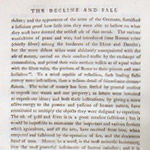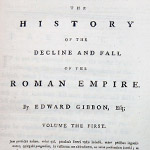 |
 |
Edward Gibbon's Decline and Fall grew out of the now famous apocryphal musing: 'It was at Rome... as I sat musing amidst the ruins of the Capitol, while barefoot friars were singing vespers in the Temple of Jupiter, that the idea of writing the decline and fall of the city first started to my mind.' This monumental literary work, akin to T.E. Lawrence's Seven Pillars of Wisdom, was finished at Lausanne, Switzerland, on 27 June 1787: 'I wrote the last lines of the last page in a summer-house in my garden.' William Strahan, Gibbon's publisher, was right: 'I will venture to say, it will ere long make a distinguished figure among the many valuable works that do honour to the present age; will be translated into most of the modern languages, and will remain a lasting monument of the genius and ability of the writer.' This is the first volume of the first edition. |

